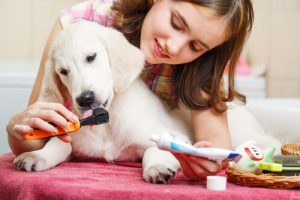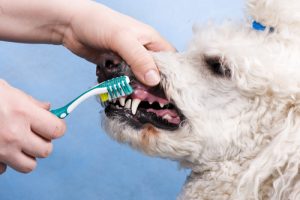Your Dog's Oral Hygiene - Don't Ignore It!

Oral hygiene is a very important part of pet care. After all, looking after your dog’s oral hygiene can improve their quality of life. And, it can even prevent nasty mouth diseases. So, do you want to find out some handy tips to help you with this important task? If so, you’ve come to the right place!
The basics of canine oral hygiene
The first thing to understand is that your dog’s oral hygiene is your responsibility. It’s an aspect of grooming that they can’t do by themselves. If your dog comes into your life as a puppy, it’s important to start taking care of its little teeth as soon as possible. After just two or three weeks, it will already have 28 teeth. Then, the permanent mature teeth won’t take much longer to grow. In fact, by the time your dog is six months old, it will already have all 42 teeth.
Consequences of poor oral hygiene
Does your dog’s oral hygiene leaves a little to be desired? It could have serious consequences, with secondary health problems appearing before it reaches the age of three. The first sign of bad oral hygiene is an excess of tartar that builds up on each tooth’s surface. This tartar is an accumulation of calcium and phosphorus. And, the tartar allows bacteria present in your dog’s mouth to grow like crazy.

These bacteria end up damaging the gums. Then, they cause a condition called gingivitis. And, this can eventually lead to tooth loss. That’s why it’s so important to make sure you’re doing what you can to look after your dog’s teeth.
How to preserve good oral hygiene
Now that we’ve learned about the risks of poor oral hygiene, let’s look at what we can do to make sure you can keep your dog’s teeth and gums clean and healthy.
- Start with a visit to the vet. It’s a good idea to ask the vet to examine your dog’s mouth and check that there aren’t any specific problems that require treatment. In general, if the vet needs to carry out a thorough examination, he or she will have to anesthetize the dog. This is a common and painless procedure, and nothing you need to worry about.
- Ask the vet to show you some techniques. Many vets will be happy to give you some advice free of charge to make sure you know the best way to brush your dog’s teeth effectively.
- Find a quality toothpaste. Whatever you do, never brush your dog’s teeth with toothpaste designed for humans – instead, look for specialized toothpaste for dogs, which will be on sale at your local vets’ practice or pet store. Make sure to choose one that has active enzymes, acts powerfully against the build-up of bacteria, and can be swallowed easily.
- Use a special canine toothbrush. There are a number of different types of toothbrush out there on the market that are designed especially for our furry friends. Ask your vet which one would be best for your pet – the answer will depend on the size of your dog’s muzzle and teeth. However, bear in mind that there are some dogs that can’t handle having their teeth brushed – for these sensitive creatures, you may be able to use something like a plastic finger cover, or another product suggested by your vet.

Some more canine oral hygiene tips
- Brush your dog’s teeth slowly and gently. Make sure you’re not brushing your dog’s teeth roughly. It’s important to approach the task slowly and calmly, so your dog doesn’t feel attacked or even try to bite you. A good first step is simply to put a dab of toothpaste on your finger and allow your dog to smell it.
- Do it frequently. The best thing would be to brush your dog’s teeth every day. But doing it consistently twice a week should be sufficient. Of course, maintain a consistent habit.
- Toys for dental health. Bones and hard chew toys are an ideal way to help to keep your pet’s mouth clean.
- Don’t forget the rewards! The dog treats that are used as a reward in positive reinforcement training can also be a great way of maintaining your dog’s oral hygiene.
By following these simple tips, you can make sure looking after your dog’s oral hygiene becomes a pain-free part of your routine. Your dog will thank you for it!
This text is provided for informational purposes only and does not replace consultation with a professional. If in doubt, consult your specialist.